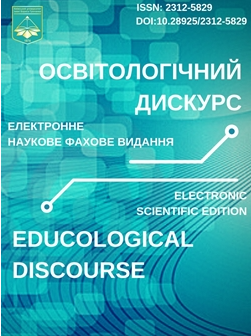The Current State of the Formation of Emotional Literacy of Older Preschool Children with Logopathology
DOI:
https://doi.org/10.28925/2312-5829.2023.16Keywords:
diagnosis of emotions, children of older preschool age, emotional literacy, emotions, speech disorderAbstract
The purpose of this study is to identify the current state of emotional literacy, which affects the speech readiness to study at school of older preschool children with logopathology. The main priority of older preschoolers is that they are already able to manage their emotions and feelings, which acquire stability and validity. During training, moral, aesthetic, motivational, cognitive feelings are built on their basis. Emotional readiness determines in children an adequate reaction to life situations, understanding of actions and consequences of emotional states (emotional prediction); awareness of one's experiences, the ability to explain one's condition (feelings become arbitrary, controlled), which is extremely important for a future student. This especially applies to children with speech pathology. The results of the experimental study give a clear idea that there are significant differences between the groups of children with logopathology and those with normotypical psychophysical development regarding the formation of the emotional component of the psychological component of speech readiness for school: insufficiently formed knowledge about schematic types of emotions, which reveals a low level of awareness and ideas about types of emotions and their properties; insufficiently developed ability to analyze the facial expressions of the close environment; not understanding what kind of emotion a person can feel in different life situations. Their knowledge is limited to a small number of emotions, so during mood swings it is difficult for them to explain their emotional state or identify it in others; during communication, negative emotions are inherent (stubbornness, behavioral negativism, anxiety, fear of something new, in particular, speech). The obtained research materials and statistical evidence allow us to conclude that the majority of older preschool children with logopathology have an insufficiently formed emotional regulation; more often than children with normotypical development, they experience negative emotions during communication both with peers and with adults. The research materials indicate the unformed readiness of this category of children to interact in the conditions of schooling.
Downloads
References
Bielova, О. (2019). Patterning types of aggressive behaviour of primary school children with speech disorders. Special education, 2(40), 201–236. http://socialwelfare.eu/index.php/SE
Bielova, О. (2021). The state of development of components of speech readiness of older preschool children with speech disorders. Special education, 1(42), 137–189. https://www.journals.vu.lt/special-education/article/view/25427
Bielova, O. B. (2022 a). Kontseptualno-metodolohichni pidkhody do diahnostyky emotsiinoho komponentu movlennievoi hotovnosti ditei starshoho doshkilnoho viku z lohopatolohiieiu [Conceptual and methodological approaches to the diagnosis of the emotional component of the speech readiness of older preschool children with speech pathology]. Innovative pedagogy, 47, 94–99. http://www.innovpedagogy.od.ua/archives/2022/47/18.pdf
Bielova, O. B. (2022 b). Metodyka vyvchennia emotsiinoi hramotnosti ditei starshoho doshkilnoho viku z lohopatolohiieiu [Methods of studying emotional literacy of older preschool children with logopathology]. Pedagogy of creative personality formation in higher and secondary schools, 82, 21–29. http://pedagogy-journal.kpu.zp.ua/archive/2022/82/3.pdf
Chiu, D. (2018). Emojis and ai to communicate non-verbal expressions of emotion: in preparation for the digitalization of doctor-patient conversations. Mirabeau, Amsterdam. The Hague University of Applied Sciences Graduation Project. 95 р. https://www.pinterest.ru/pin/469852173622809487
Churches, O., Nicholls, M., Thiessen, M., Kohler, M., & Keage, H. (2014). Emoticons in mind: An event-related potential study. Social Neuroscience, 196–202.
Conte, E., Ornaghi, V., Grazzani, I., Pepe, A. & Cavioni, V. (2019). Emotion Knowledge, Theory of Mind, and Language in Young Children: Testing a Comprehensive Conceptual Model. Frontiers in Psychology. Sec. Developmental Psychology. https://doi.org/10.3389/fpsyg.2019.02144
Ekman, P., & Cordaro, D. (2011). What is Meant by Calling Emotions Basic. Emotion Review, 3(4), 364–370.
Fredrickson, B. L., Devine, In P. and Plant, A. (2013). Positive emotions broaden and build (Eds.) Advances in Experimental Social Psychology, 47, 1–53.
Gray, J. (1982). On the classification of the emotions. Behavioral and Brain Sciences,5(3), 431–432. doi:10.1017/S0140525X00012851
Jibril, T. A., & Abdullah, M. H. (2013). Relevance of Emoticons in Computer-Mediated Communication Contexts: Overview. Asian Social Science, 201–207.
Mayer, J. D., Salovey, P., Caruso, D. R. (2004). Emotional Intelligence: Theory, Findings, and Implications. Psychological Inquiry, 15(3), 197–215.
Moroz, V.Ya. (2017). Ekspresyvnyi dyskurs: syntaksychni zasoby vyrazhennia [Expressive discourse: syntactic means of expression]. Vinnytsia: Nilan-LTD LLC, 106 p.
Murray, J., Palaiologou, I. (2018). Young children’s emotional experiences. Early Child Development and Care, 188, https://doi.org/10.1080/03004430.2018.1449839
Panksepp, J., & Davis, K. (2018). The Emotional Foundations of Personality: A Neurobiological and Evolutionary Approach. New York: W. W. Norton & Company. 352 р.
Russell, J. A., & Bullock, M. (1985). Multidimensional scaling of emotional facial expressions: Similarity from preschoolers to adults. Journal of Personality and Social Psychology, 48(5), 1290–1298.
Saarni, C., & Camras, L. A. (2023). Emotional Development in Childhood. In: Tremblay R. E., Boivin M., Peters R.De.V, eds. Encyclopedia on Early Childhood Development. https://www.child-encyclopedia.com/emotions/according-experts/emotional-development-childhood.
Serrat, E., Amadо, A., Rostan, C., Caparrоs, B., & Sidera, F. (2020). Identifying Emotional Expressions: Children’s Reasoning About Pretend Emotions of Sadness and Anger. Frontiers in Psychology. Sec. Perception Science. https://doi.org/10.3389/fpsyg.2020.602385
Spackman, M., Fujiki, M., & Brinton, B. (2006). Understanding emotions in context: The effects of language impairment on children's ability to infer emotional reactions. International Journal of Language & Communication Disorders, 41(2), 173–188. https://doi.org/10.1080/13682820500224091
Steiner, C., & Perry, P. (2003). Achieving emotional literacy. La educación emocional. Simon & Shuster Sound Ideas; Abridged edition, 1997.
Tong, E. (2014). Differentiation of 13 positive emotions by appraisals. Cognition and Emotion, 29(3), 487–489.
Wenche, A. Helland, Maj-Britt, Posserud & Astri, J. Lundervold. (2022). Emotional and behavioural function in children with language problems- a longitudinal, population-based study. European Journal of Special Needs Education, 37(2), 177–190. https://www.tandfonline.com/doi/full/10.1080/08856257.2020.1857930
Zareen, N., Karim, N., & Khan, U. A. (2016). Psycho Emotional Impact of Social Media Emojis. ISRA Medical Journal, 257–262.
Published
How to Cite
Issue
Section
License
Copyright (c) 2023 Educological discourse

This work is licensed under a Creative Commons Attribution-NonCommercial 4.0 International License.
Автори зберігають за собою всі авторські права та одночасно надають журналу право першої публікації на умовах лізенції Creative Commons Attribution-NonCommercial-ShareAlike 3.0 Unported License, що дозволяє розповсюджувати даний матеріал із зазначенням авторства та первинної публікації в даному журналі.





















